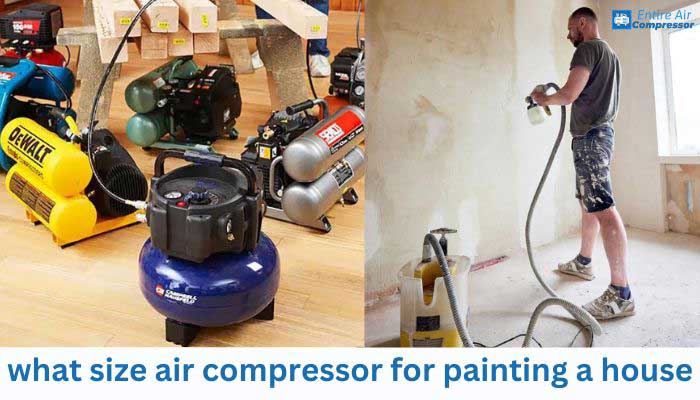What size air compressor for painting a house? When it comes to house painting, using an air compressor can significantly enhance the efficiency and quality of the job. Air compressors power various pneumatic tools, such as spray guns and paint sprayers, delivering a consistent flow of air pressure to ensure smooth and even paint application. However, choosing the right size air compressor is crucial to achieve the best results for your painting project. In this article, we will delve into the factors that influence the selection of the appropriate air compressor size for painting a house.
Factors to consider choosing the right air compressor


Before determining the size of the air compressor for your painting needs, several essential factors must be considered.
- Painting Equipment Requirements: Different painting tools, such as HVLP spray guns and airless sprayers, have varying air compressor requirements. Some tools demand higher air volume (CFM) and pressure to function optimally. Understanding the specifications of your painting equipment is vital in making the right air compressor choice.
- Paint Consumption: The volume of paint needed for your project plays a significant role in determining the air compressor’s capacity. Larger painting jobs with high paint consumption require a more powerful air compressor with a higher CFM rating.
- Pressure and Volume (CFM): For efficient painting, the air compressor must provide an adequate balance of pressure and volume. CFM measures the volume of air delivered by the compressor per minute, while air pressure is essential for achieving the desired spray patterns and paint flow.
- Surface Area and Complexity: The size and complexity of the house’s surface to be painted will influence the air compressor’s power requirements. Painting large or textured surfaces may require a more powerful compressor to maintain consistent airflow.
- Continuous vs. Intermittent Usage: Consider whether your painting task is continuous or intermittent. Continuous painting jobs, such as large exterior projects, demand an air compressor with a higher duty cycle and sustained airflow, while intermittent usage may allow for a smaller compressor.
Calculating the Right Air Compressor Size
To determine the appropriate air compressor size for your house painting project, follow these steps:
- Determine CFM Requirements: Identify the CFM requirement of your paint spray gun or paint sprayer. This information can usually be found in the tool’s user manual or on the manufacturer’s website.
- Calculate Maximum PSI: Determine the maximum PSI (pounds per square inch) needed for your painting equipment. Again, refer to the tool’s specifications to find this value.
- Consider Duty Cycle: If you have continuous painting tasks, pay attention to the duty cycle of the air compressor. Duty cycle refers to the amount of time the compressor can operate within a specific period without overheating.
- Total CFM and PSI Needed: Combine the CFM and PSI requirements of all your painting tools to calculate the total CFM and PSI needed from the air compressor. Ensure that the compressor you choose meets or exceeds these requirements.
Recommended Air Compressor Sizes


Based on different house painting scenarios, here are the recommended air compressor sizes:
- Small DIY Projects: For small-scale DIY house painting projects, a portable air compressor with a tank size of around 6 gallons and a CFM rating of 2-3 CFM at 90 PSI should suffice. Portable electric air compressors, such as the PORTER-CABLE Air Compressor, are suitable for these tasks.
- Medium-Sized Houses: Painting medium-sized houses requires a more powerful air compressor. A compressor with a larger tank capacity (e.g., 30 gallons) and a CFM rating of 5-6 CFM at 90 PSI is recommended. Consider a single-stage air compressor for consistent flow and optimal performance.
- Large Houses or Commercial Projects: For painting large houses or commercial projects, a heavy-duty air compressor is necessary. Look for a compressor with a larger tank (e.g., 60 gallons) and a higher CFM rating (8 CFM or more at 90 PSI). Two-stage air compressors with continuous flow capabilities are ideal for such extensive painting tasks.
Conclusion
Selecting the right size air compressor is crucial for achieving efficient and effective house painting results. Consider factors such as painting equipment requirements, paint consumption, pressure and volume (CFM), surface area complexity, and usage patterns when choosing an air compressor. By following the step-by-step guide to calculate the appropriate size, you can ensure that your air compressor meets the demands of your painting project.
FAQ (what size air compressor for painting a house)
- What happens if I use an undersized air compressor for house painting? Using an undersized air compressor may lead to issues such as uneven paint coverage, frequent interruptions as the compressor struggles to keep up with demand, and potential damage to the painting equipment due to excessive strain.
- Can I use a larger air compressor than recommended for painting? While using a slightly larger air compressor is generally acceptable, using a significantly oversized compressor may result in wasted energy and increased equipment cost. It’s best to stick as close as possible to the recommended size.
- Are there any portable air compressors suitable for house painting? Yes, there are portable air compressor models available for smaller house painting projects. Look for electric, oil-free air compressors with a sufficient CFM rating for your painting equipment.
- What other accessories do I need with my air compressor for house painting? Essential accessories include hoses, regulators, and filters to ensure optimal performance during house painting tasks. An intake silencer filter can help maintain clean air intake, especially in dusty environments.
- How do I maintain my air compressor to extend its lifespan? Regular maintenance is essential to prolonging the lifespan of your air compressor. Keep the air compressor clean, change air filters regularly, and drain the water from the tank using the water drain valve after each use.
- Can I rent an air compressor for house painting instead of buying one? Renting an air compressor can be a cost-effective option for one-time or occasional painting projects. However, for frequent painting tasks, investing in a quality air compressor can be more economical in the long run.
By carefully considering your painting requirements and following the guidelines provided in this article, you can confidently choose the right air compressor size for your house painting needs. A well-suited air compressor will ensure consistent airflow, smooth paint application, and a professional-looking finish for your painting project.
Read more resources about air compressor for painting :
- Small air compressor to use in painting
- Does a paint sprayer require an air compressor?
- What size air compressors for painting furniture?


Hello! I am fahim zaman. I am an expert of air compressor and working with it for a long time. I will make it easy to understand the problems of air compressor and fix it.


